|
Canoedling With a Gramophone
by Keith Wright
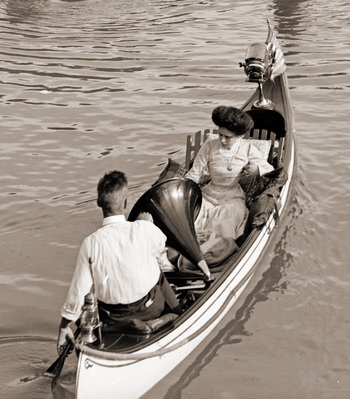
|
|
On the Grand Canal at Belle Isle Park, in Detroit, circa 1907, two boaters take advantage of canoe luxuries like reclining seats and phonograph music.
(Image courtesy Collectors Weekly)
|
|
|
"A Canadian is someone who knows how to make love in a canoe without tipping it," Pierre Berton.
"Anyone can make love in a canoe, it’s a Canadian who knows enough to take out the centre thwart!" Alex Brown (Collectors Weekly, Dec. 6, 2012).
"The [canoes] with removable thwarts were called 'girling' canoes. I can only imagine why they were called that." (Classic Camp Stoves - posting from 2008).
"Re - my enquiry earlier this year about the Girling of GIRLING CANOE. It seems this is not named after a Girling but for what it was used for." Reuben B. Girling (a "rootsweb" posting from 2003).
"The ordinary open canoes are coming into greater use each year in the United States. For pleasure paddling and exercise, and especially for 'girling', they are unequalled." (Forest and Stream, 1889).
"We thought when the 'girling canoe' was finally christened a couple of years ago that the demands of every class of canoeist were fully provided for, but each new season seems to bring its particular
specialty…The first 'war canoe' was devised by the Toronto C.C. and built by the Ontario Canoe Co." (Forest and Stream, 1890).
"[The Sunnyside Cruiser canoe] developed by Walter Dean in 1910 for use in the Lake Ontario waters off Sunnyside Beach, Toronto, [is a] fast efficient cruiser [that] often doubles as a 'girling' canoe. It was so
popular that it soon accounted for 90 percent of Dean’s business." (Canoecraft: A Harrowsmith Illustrated Guide to Fine Woodstrip Construction, Ted Moores and Merily Mohr, Firefly Books, 1983.)
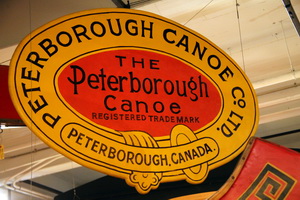
|
|
The Comfort line was built by the Peterborough Canoe Company in the early years of the 20th century.
(Image courtesy Keith Wright)
|
|
|
In 1903, in addition to banning drinking and gambling on a six-mile stretch of the Charles River, the Metropolitan Parks Commission in Massachusetts also outlawed kissing on canoes, punishable by a $20 fine.
A contemporary Boston Herald article noted that, "At that rate it is estimated that over a million dollars' worth of kisses are exchanged at that popular canoeing resort every fine Saturday night and Sunday."
The Canadian Canoe Museum in Peterborough comes across as very professional with very modern exhibits. I have passed many 'interesting' museums in my cross-Canada trips—such as the Canadian Bushplane
Heritage Centre in Sault Ste. Marie—but since my interest in small sail-less water craft rivals that of my interest in bushplanes, it surprised even me that I once drove deliberately to Peterborough to visit. To be honest,
I was on a mission to see a phonograph.
The sign for the phonographic canoe says, "Cedar-strip, Comfort Courting Canoe. Peterborough Canoe Company, 1904 [?]. This cedar-strip mahogany-decked canoe has a long bow deck which continues along each
side and forms into two cabinets, designed to hold a built in phonograph, records and liquid refreshments. For romantic outings the lady was seated in the bow, facing her suitor while he paddled. This canoe is very
rare and only a few were ever built. On loan from Ralph and Nancy Andrews."
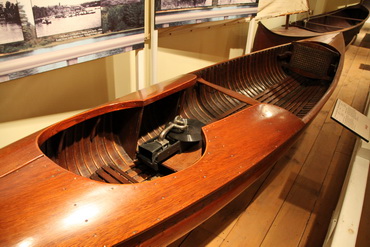
|
|
Cedar-strip, Comfort Courting Canoe—with removable centre thwart.
(Image courtesy Keith Wright)
|
|
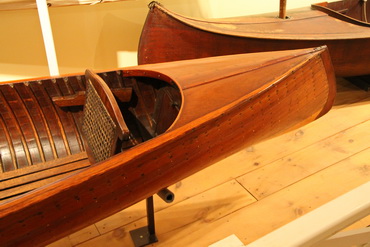
|
|
Seat flipped down, as a backrest with small locker directly behind.
(Image courtesy Keith Wright)
|
|
|
I tried to dig further but the Wood Canoe Identification Guide doesn’t list individual craft for the Peterborough company prior to 1909 and the closest match name-wise was the "Solid Comfort" line. However it did
mention that, "The Peterborough Canoe Company was formed in 1892 … just weeks before the Ontario Canoe Company burned down in May 1892. Col. James Z. Rogers, formerly president, general manager and
one-third owner of the Ontario Canoe Company owned 4% of the new company and became manager in 1893. The company continued to build the wide-board, cedar-strip and cedar-rib canoes much like the Ontario
Canoe Company had before them…The Peterborough Canoe Company closed its doors in 1961."

|
|
Two cabinets, designed to hold a built-in phonograph, records and liquid refreshments.
(Image courtesy Keith Wright)
|
|
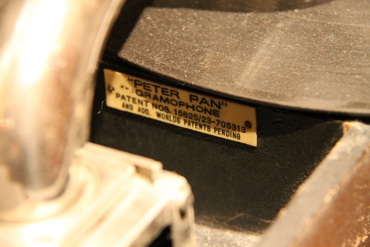
|
|
The display phonograph is a Peter Pan portable built in England in the mid-1920s, disguised as a box camera.
(Image courtesy Keith Wright)
|
|
|
The phonograph that is exhibited with the canoe is a typical "camera" type machine popular for some reason in the 20s and 30s. That isn’t surprising as the locker available for its storage is small and makes me
wonder what phonograph they would have had in mind in 1904—if that is the correct year.
"Where the purpose of the canoe becomes apparent is in the arrangement of the bow. Here the young lady would sit on a contoured wooden seat, facing sternwards, with her back against the long bow deck.

|
|
Punishable by a $20 fine! The word most likely evolved from the German term "knuddeln", meaning "to cuddle."
(Image courtesy Canadian Canoe Museum)
|
|
|
Directly across from the phonograph locker,
presumably for purposes of weight distribution, is another small locker designed to house the record collection. Please note that this phonograph was not intended to be used when the boat was in motion; for one thing,
when deployed it takes up the space required for the feet of the person sitting in the bow. No, the phonograph was intended for the provision of music while the happy couple was lunching in some secluded cove or inlet."
(source, A Canoe Made For Courting).
For further reading:
- Love Boats: The Delightfully Sinful History of Canoes
- Bringing the Canoes to Life: "Joy-tub" - Canoes for Courting
- A Canoe Made For Courting
Thanks to Bill Pratt for the original tip.
|